One of our favourite things about the legendary Stratocaster is that it’s a pickguard design, meaning almost all of the serviceable parts are mounted straight onto an easily removable pickguard. This makes jobs like the one we'll walk you through below relatively straightforward.
In contrast, take a look at a Les Paul. If you decide to re-wire that you'll have to run cables up through the middle of the guitar; put the pickups in in the same way; do what wiring you can out of the guitar; and solder the rest - while not being very careful not to melt the sides of the electronics cavity. Yes, all-in-all, we'd rather be working on a Strat at this point.
Upgrade parts for Strats are plentiful, so selecting the right gear is in fact harder than fitting it. The owner of this American Professional Strat opted for some Klein Epic 1962 pickups as a matching set. He’s also supplied us with a partially wired loom, including some nice parts all mounted on a new Fender pickguard.
We’ll build the pickguard up, solder it and fit it to the guitar.
What you need

- Flash new pickups
- Pickup mounting screws & springs
- Pickup covers
- New pickguard
- New knobs
- New switch tip
- Wire cutters
- 60/40 solder
- Partially soldered wiring loom
- 40 watt soldering iron
- PH1 and PH2 screwdrivers
- Adjustable spanner
- Wiring diagram
Step 1 - the pickups
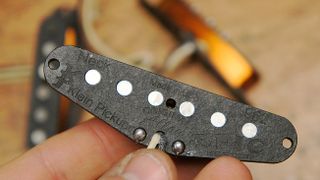
We have a set of nearly identical matched pickups - but which one’s which? This brand helpfully tells us on the rear! If you have no clue, you can connect the hookup wires to a multimeter and test the resistance - the one with the highest resistance is likely to be the bridge.
Step 2 - attach the pickups

Carefully put your new pickups inside their plastic covers. Those fine winds are incredibly delicate - we’ve seen them break with the help of a screw getting attracted to them many times. The pickup screws go through the guard, through the spring and into the forbon pickup baseplate. Yes, it’s fiddly - the spring can fly off.
Step 3 - pot popping
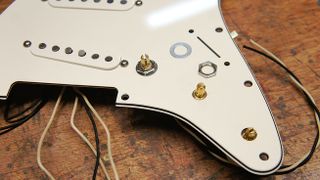
Don’t worry about setting the pickups’ final height yet; that’s done when they’re strung up. Time to pop the pots through - the star washer goes on the back and helps the pot grab onto the rear of the pickguard. Be very careful not to damage your pickguard though - line the edges of your spanner with masking tape just to be sure.
Step 4 - alignment

Fit the pickup selector through the slot in the pickguard, and tighten it up. The knobs and the switch tip just push on. These are small details, but this is the ‘official’ Fender knob alignment! Twist the metal pot shaft all the way to 10, then line up the 10 on the volume knob with the pickup screw. Call us fussy...
Step 5 - tidy up
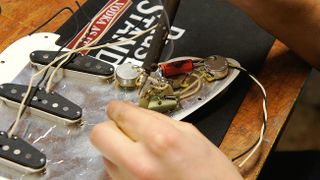
Flip the ’guard over to complete the circuit. There are six pickup wires that need sending home, but this is an easy task with a wiring diagram. Get the soldering iron on and let it warm up fully (conveniently the time it takes to brew up). Each cable is trimmed to length, wire exposed then tinned, along with the receiving solder lug.
Step 6 - solder

With everything in place, it’s time to solder. Join up the three white wires to the pickup selector lugs. There should be a medium blob of solder on the volume pot, ready to receive the black ground wires. Twist those three together, and solder them on with plenty of heat.
Step 7 - more tidying

Tidy up your cables. We’re doing our best, so it may as well look the part too. Can you see the three wires hanging off? They’re the hot and ground going to the jack socket, and one more black wire that’s just been attached. That’s the tremolo claw wire or ‘string ground’. We’ll solder those on in a moment.
Step 8 - old guard
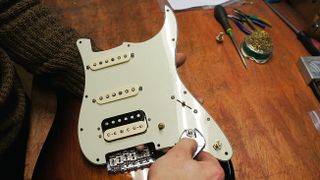
Now we’ve got our lovely new guard ready to go, let’s strip down the old one. Loosen off all the parts from the old pickguard and stash all the small screws. Make sure they do not find a way to get stuck to a pickup, as they will break it given half a chance.
Step 9
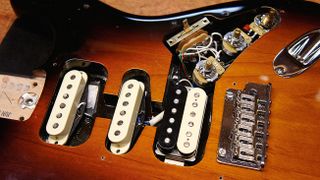
With these delightful old guts on show, there are only three wires holding it in place - and those are exactly the three wires that we need to solder when our new ones go in. Remove the jack socket plate and chop the 2 jack wire; chop the tremolo claw wire too.
Step 10 - fit the new guard

Now it’s time to introduce the new guard to the body. Post the jack wires hot and ground through the small opening, sending them to the jack socket rout. The tremolo claw wire needs to be sent through too; this hole is usually harder to find, but it is there!
Step 11 - new jack
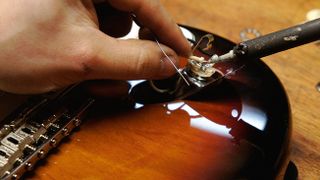
We’re using the brand-new Switchcraft jack socket, so that’s been tinned and is now getting the two wires soldered on. By the way, this is the correct way to orient the jack socket component - long leg downward. This gives the sprung leg on the jack socket enough room to click in correctly.
Step 12 - finish up

Due to its size, the tremolo claw saps the heat from your iron, making it difficult to get a good solder joint. An 80-watt soldering iron excels here, but 40 watts will just take longer to reach temperature. Get a decent pool of solder on there to be sure. We’re done! Screw on the ’guard and marvel at your handiwork.

